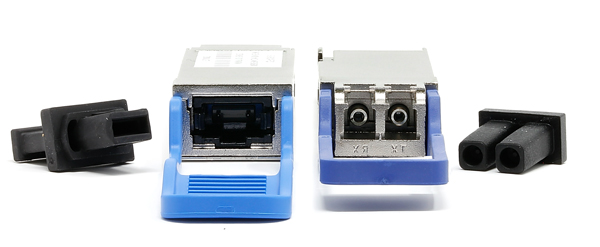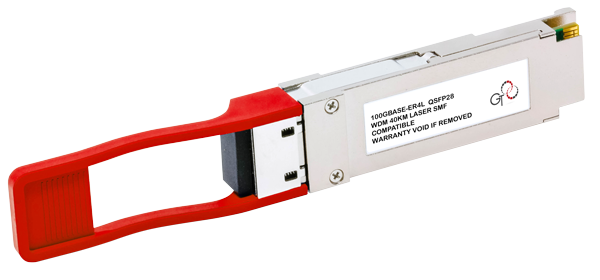The Different Types of QSFP+ & QSFP28 Transceivers
Parallel & WDM Applications
Why are there two different connector types for QSFP 40G and 100G transceivers?
The use of MTP/MPO or LC Duplex connectors with QSFP transceiver modules depends on the specific requirements of the networking application. MTP/MPO connectors are used for Parallel transmission of data, while LC Duplex connectors are used for WDM transmission of data. There are three main reasons why one is used over the other.
-
Breakout Capability
Parallel – Can be broken out from 40G to 4x 10G or 100G to 4x 25G
WDM – Only used for 40G to 40G or 100G to 100G connections. Not able to breakout. -
Distance Requirements
Parallel – Limited to 10km for 40G connections and 2km for 100G connections
WDM – Can be used for connections up to 80km and beyond. -
Existing Wiring
Parallel – MTP/MPO wiring is not very common and is more expensive than standard duplex wiring.
WDM – Can use existing duplex infrastructure and is much less expensive.

MTP
LC
What is Parallel?
Parallel signal in Multimode as well as Singlemode PSM4 (Parallel Single-Mode 4 Fiber) QSFP transceivers are optical modules that use multiple lanes or channels to transmit and receive data simultaneously. This requires 4 fibers in each direction but enables simpler transceiver design since all signals can have same wavelength and no optical MUX/DEMUX is required. These transceivers run over MPO (MTP) connectors and can be paired directly or broken out into 4x10G SFP+ or 4x25G SFP28 to interconnect devices operating at lower speeds.
What is WDM?
Wave Division Multiplexing (WDM) is a technology for transmitting multiple optical signals through the same fiber. All signals have different wavelengths (colors). 40/100G WDM transceivers make it possible to reduce the number of fibers in the link to two, one for transmit, and one for receive for a direct connection. This also allows for further distances the optics can travel, some spanning as far as 80km distances.
Example Charts & Diagrams
40G & 100G SR4 Parallel Connections
The 40G QSFP+ & 100G QSFP28 SR4 transceiver are designed to facilitate the conversion of parallel electrical input signals into parallel optical signals, leveraging a driven Vertical Cavity Surface Emitting Laser (VCSEL) array. In turn, the receiver module allows for the conversion of parallel optical input signals through a photo detector array into parallel electrical output signals. The differential nature of all data signals enables the support of data rates up to 10Gb/s per channel in QSFP+, and 25Gb/s incorporating QSFP28. These transceivers incorporate MTP connectors to utilize all 8 lanes.
Applications


40GBase-SR4 QSFP+ Parallel Connection over MTP





40GBase-SR4 QSFP+ Breakout to 4x 10GBase-SR SFP+
40G CWDM / 100G LAN-WDM Connections
Wavelength Division Multiplexing (WDM) is a technology used in fiber optic transceivers, including QSFP+ 40G and QSFP28 100G transceivers, to transmit multiple data channels over a single optical fiber using different wavelengths of light. In 40G QSFP+, CWDM (Course Wavelength Division Multiplexing) is generally incorporated in wavelengths spanning 1271nm, 1291nm, 1310nm & 1331nm. In 100G QSFP28, LAN-WDM technology is incorporated spanning 1295nm, 1300nm, 1304nm, & 1309nm to achieve higher signal output. Both types run over an LC Duplex patch cable.
Application


Form Factors and key information on deployment
QSFP+ (Quad Small Form-factor Pluggable Plus)
Denotes Transceivers/Cables operating over 4x10G Channels with a supported data rate of 40Gbps over 4 lanes. Capable of 40Gb/s Ethernet, InfiniBand QDR (Quad Data Rate), & Fibre Channel 4x16 standard.
QSFP28 (Quad Small Form-factor Pluggable Plus 28)
Denotes Transceivers/Cables operating over 100Gbps transmission. The “28” notes the modules support of up to 28 gigabits per second per channel. Capable of 4x(25-28G) transmission lanes supporting 100Gb/s Ethernet, InfiniBand EDR (Extended Data Rate), & Fibre Channel 4x32 standard.
WDM (Wavelength Division Multiplexing)
A technology for transmitting multiple optical signals through the same fiber. All signals have different wavelengths (colors). 40/100G WDM transceivers make it possible to reduce the number of fibers in the link to two, one for transmit, and one for receive for a direct connection.
CWDM (Course Wavelength Division Multiplexing)
Employs a wide 20nm laser wavelength spacing used in Singlemode links and because of the wide wavelength spacing does not require a cooler, so less expensive than other alternatives. 40/100G CWDM Transceivers typically use an LC Duplex (2-Fiber), to transmit and receive.
DWDM (Dense Wavelength Division Multiplexing)
Employs a very narrow 0.8nm (100GHz) / 0.4nm (50GHz) laser wavelength spacing used in Singlemode links. The laser needs to be temperature controlled so these devices usually employ an electrical cooler, making them more expensive than CWDM options.
LWDM (LAN-Wavelength Division Multiplexing)
With speeds growing higher into the 100G realm, LAN-WDM was introduced in order to maximize a transceivers ability to operate further distances with less chromatic dispersion. Operating at 1295nm, 1300nm, 1304nm & 1309nm, the wavelengths are more tightly spaced and centered around zero-dispersion wavelength of the fiber.
SWDM (Short Wave Division Multiplexing)
SWDM refers to the use of multiple short-wavelength optical signals to transmit data over a single optical fiber using wavelength division multiplexing. SWDM typically uses four different wavelengths, which are closely spaced in the short-wavelength range, such as 850 nm, 880 nm, 910 nm, and 940 nm, to transmit multiple data channels simultaneously over a single fiber. This application is designed for Multimode fiber. 40/100G SWDM Transceivers typically use an LC Duplex (2-Fiber), to transmit and receive.
Parallel QSFP in Multimode
Parallel Quad Small Form-factor Pluggable transceivers, are optical transceiver modules that use multiple lanes or channels to transmit and receive data simultaneously over multimode fibers (MMF) in parallel. They are commonly used in high-speed data center and telecommunications networks for short-range optical links. They typically use multi-fiber MPO (MTP) connectors and can be paired directly or broken out into 4x10G (QSFP+) or 4x25G (QSFP28) to interconnect devices operating at lower speeds.
PSM4 (Parallel Single-Mode 4 fiber)
The opposite of WDM in the sense that each signal is transferred in its own fiber. This requires 4 fibers in each direction but enables simpler transceiver design since all signals can have same wavelength and no optical MUX/DEMUX is required. These transceivers run over Singlemode MPO (MTP) APC connectors and can be paired directly or broken out into 4x10G (QSFP+) or 4x25G (QSFP28) to interconnect devices operating at lower speeds.
GigaTech QSFP
40GBase QSFP+
100GBase QSFP28
Why use GigaTech Products BiDi Solutions
At GigaTech, you can find a wide variety of BiDi transceivers that are designed to meet and exceed industry standards. Our transceiver solutions are not only reliable but also cost-effective and flexible, providing you with the ability to make necessary changes and accommodate network growth with ease. Our transceivers are tested to ensure they perform at the highest possible level and are designed to work seamlessly with your existing network infrastructure. You can trust GigaTech to provide you with transceiver solutions that will meet your needs now and in the future.

Never Sourced. Never Recycled.
All components in GigaTech Product optics are manufactured under the same roof and represent the gold standard for reliability and consistency in performance. This vertical manufacture chain allows GigaTech to avoid unnecessary variances in transceiver casing or laser quality often found with online resellers who source their components from an ever changing vendor list. The transceiver is guaranteed to be built from A-Stock never used components overseen by GigaTech Products,
Rigorous Testing & Standards Compliance
The quality and standards of our hardware is one the base foundations of GigaTech Products. All of our components comply with MSA (Multi-Source Agreement) output standards and, in many cases, excel beyond those certification standards. Every transceiver we produce is tested on active network devices to ensure they comply with OEM equipment and are verified to be plug-and-play and do not require work arounds.
